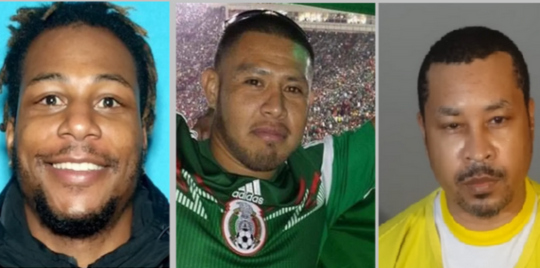Photo: LAPD\Sanchez Family
On Wednesday, the Los Angeles Police Department released video footage of separate incidents in which LAPD officers killed three men in the span of 48 hours: Takar Smith (above left), Oscar Leon Sanchez (above middle), and Keenan Anderson (above right).
CPE is mindful that such videos provoke renewed trauma and fresh grieving among those close to the person whose life was taken, as well as in the broader community. We stand with the families and loved ones of each victim, who are now forced to relive those tragic events and grapple with the repetitive public review of one of the most difficult moments of their lives as they seek accountability. Even as we acknowledge the importance such footage can play in achieving that accountability, we must not forget that it, too, exacts a painful toll.
On January 2, Takar Smith, a Black man, was experiencing a mental health crisis; his wife Shameka requested assistance from law enforcement. Officers arrived hours later and asked her to wait outside; Shameka recalls saying: “Please don’t kill my husband. He’s not in his right mind.” LAPD officers spent about half an hour in the house, at which point Takar can be seen picking up an object in his kitchen; police have said it was a knife.
An unknown number of officers immediately opened fire, killing him.
On January 3, Oscar Leon Sanchez, a Latino man, was also experiencing a mental health crisis. Police responded to a call concerning a man who had allegedly threatened someone with a knife and found Sanchez in an abandoned building. LAPD has said that Sanchez stepped toward them with an object in hand.
Officers opened fire with both live and non-lethal rounds. Sanchez was hit with a live round and killed.
Also on January 3, Keenan Anderson, a Black man, was involved in a traffic accident. When police arrived, bystanders identified him as possibly being responsible for the collision. An officer pursued Anderson on a motorcycle and after a brief exchange on a nearby sidewalk, Anderson began to run. The officer pursued him again and was joined by other officers; a visibly terrified Anderson, begging for his life, was repeatedly tased and restrained with an elbow to his neck.
He was then arrested and transferred to a hospital, where he was pronounced dead.
While separate, these three incidents are part of a much broader context in which LAPD officers, tasked with maintaining public safety, frequently endanger and far too often kill members of the public they are meant to serve. These deadly consequences are very often the result of officers being sent into circumstances for which they have not been trained or equipped. This is a direct outcome of the nation’s insistence on building systems of punishment where systems of care are needed. An LAPD program designed to help address this imbalance by providing teams comprised of mental health professionals paired with police officers is insufficiently staffed and only consistently able to answer about a third of the calls it receives.
Lack of preparedness, however, is no excuse. It is well-established that sending armed officers into mental health crises frequently leads to the killing of the very person in need of support. A Washington Post investigation found that a quarter of the people shot and killed by police in the United States in 2015 were, as in the cases of Smith and Sanchez, “mentally unstable.” And regardless of any possible involvement in a traffic accident, there can be no justification for violently restraining Anderson and repeatedly tasing him, at one point for thirty seconds without interruption.
That all three horrific killings took place within 48 hours shocks the conscience and speaks to the enormity of the threat that police pose to Black and Brown people, a continuation of the nation’s history of visiting violence on the bodies of Black and Brown people for the purposes of compliance and control in the name of public safety. Indeed, just a week prior, the Los Angeles Times reported that law enforcement had killed close to 1,000 people in LA County since 2000: 54% of these were Latino, despite Latinos making up some 49% of the county’s population, and 24% were Black, despite Black people making up only 8% of the county’s population.
The killings of Smith, Sanchez, and Anderson were unspeakably brutal. Those responsible for the trauma now carried by their families and communities must be held accountable, but we dare not stop there. Though individual officers fired their weapons in each incident, they were behaving in a manner commensurate with the structures, systems, and expectations within which law enforcement functions in this country. This status quo cannot be allowed to stand.
We send our heartfelt condolences and wishes for peace to all who now mourn. CPE remains wholly committed to advancing the work of racial equity, toward a future in which such losses will no longer have to be endured.





